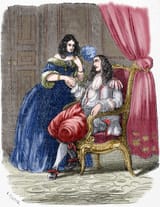Search Results
7/9/2025, 2:05:27 AM
>>509877330
>However, according to what he says, Montespan's intentions were changing, and the rituals, which were of love, were changing to hate, and the rituals became increasingly macabre, with the intention of killing the king, although there was no success. Soon after the group was discovered by La Reine, several people were arrested, including Montespan, who was later acquitted and spent the rest of her life in the interior of the country
>Catherine Deshayes (1640-1680) was a central figure in a scandal that involved murders, sacrificed babies and black masses among the nobility of Louis XIV's France
>Catherine Deshayes was born into a poor Paris family around 1640. Possibly the daughter of a sorceress, Catherine herself began practicing palmistry, face reading, and astrology at the age of 9. At 20, she married an unsuccessful jeweler and had to expand her business to support her family
>It was the preparation of aphrodisiac potions and amulets for clients that earned him a ticket into noble circles in Paris. Men sought it to increase sexual vigor, and women sought potions and aesthetic treatments that “made their breasts fuller and their mouths smaller”, as a marquis of the time noted
>Eventually, Deshayes noticed that the most common desire among customers was the so-called “heritage powder”, that is, poison. Seeing opportunity in the macabre side of witchcraft, the quiet seer began preparing poisons and celebrating satanic rituals in her hut on the outskirts of the capital. Thus, she earned the nickname La Voisin (“the neighbor”, in French)
>Her most important client was the Marquise de Montespan, one of King Louis XIV's most temperamental lovers. The noblewoman's involvement with La Voisin went far beyond aphrodisiacs and black masses: Montespan used the sorceress's poisons against a rival lover and possibly conspired with La Voisin to poison the king himself
>However, according to what he says, Montespan's intentions were changing, and the rituals, which were of love, were changing to hate, and the rituals became increasingly macabre, with the intention of killing the king, although there was no success. Soon after the group was discovered by La Reine, several people were arrested, including Montespan, who was later acquitted and spent the rest of her life in the interior of the country
>Catherine Deshayes (1640-1680) was a central figure in a scandal that involved murders, sacrificed babies and black masses among the nobility of Louis XIV's France
>Catherine Deshayes was born into a poor Paris family around 1640. Possibly the daughter of a sorceress, Catherine herself began practicing palmistry, face reading, and astrology at the age of 9. At 20, she married an unsuccessful jeweler and had to expand her business to support her family
>It was the preparation of aphrodisiac potions and amulets for clients that earned him a ticket into noble circles in Paris. Men sought it to increase sexual vigor, and women sought potions and aesthetic treatments that “made their breasts fuller and their mouths smaller”, as a marquis of the time noted
>Eventually, Deshayes noticed that the most common desire among customers was the so-called “heritage powder”, that is, poison. Seeing opportunity in the macabre side of witchcraft, the quiet seer began preparing poisons and celebrating satanic rituals in her hut on the outskirts of the capital. Thus, she earned the nickname La Voisin (“the neighbor”, in French)
>Her most important client was the Marquise de Montespan, one of King Louis XIV's most temperamental lovers. The noblewoman's involvement with La Voisin went far beyond aphrodisiacs and black masses: Montespan used the sorceress's poisons against a rival lover and possibly conspired with La Voisin to poison the king himself
Page 1
